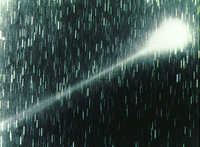Meteor shower to bring gold to Earth in October
 In early October, a powerful meteor shower will come down to Earth. It will be brought by comet Giacobini-Zinner, which passes near our planet quite often. However, meteors shower are rear enough, but it is possible that they have contributed to the emergence of gold on the planet and even the origin of life, scientists believe.
In early October, a powerful meteor shower will come down to Earth. It will be brought by comet Giacobini-Zinner, which passes near our planet quite often. However, meteors shower are rear enough, but it is possible that they have contributed to the emergence of gold on the planet and even the origin of life, scientists believe.
Giacobini-Zinner was discovered in the beginning of the last century. "It passes near Earth from time to time and rotates around the sun. It is affected by solar radiation, and emits a certain amount of gas and dust," says the head of the Zvenigorod Observatory of the Institute of Astronomy Sergei Barabanov. "To the naked eye only meteors are visible. These are dust particles and even small pieces of ice."
Comets are still being studied. According to one theory, they are remnants of the material from which nearly five billion years ago the solar system was born. Typically, these celestial bodies are composed of gas, dust and ice. According to some researchers, it was comets that brought water to Earth. "Earth's water that flows in our rivers and oceans is the water delivered by comets," said Head of the Laboratory of the Institute of Space Research Igor Mitrofanov. "After the formation of early Earth, it was very hot and there was practically no water, then for hundreds of billions of years the water was brought by comets." However, this theory is not shared by all scientists. Vernadsky in his time showed that 90 percent of all water on the planet has terrestrial origin (he made this conclusion based on the distribution patterns of different isotopes). However, the remaining 10 percent could have been brought by different celestial bodies.
Meteors are linked with the emergence of precious metals on our planet. According to the British and Swiss scientists, 200 million years after its formation, the Earth has been heavily bombarded by meteorites. Along with the asteroid matter the planet was hit with precious metals like gold, silver and platinum.
These metals are heavy, and some geochemists estimate that they should have been shifted to the core of the planet in the early stages of its formation (under the force of gravity). However, these metals are still far from the surface. Where do they come from? They could have been brought by meteorites, scientists believe.
Researchers from Leicester University built a computer model and concluded that the formation of the precious metals was contributed by the nuclear reactions caused by the collision of two super-dense bodies. As a result, heavier elements were separated from lighter elements such as iron and nickel. They travelled around the galaxy, and became part of the gas concentrations that over time turned into a comet. The researchers believe that it happened more than once. However, it takes millions of years for "precious" dust to settle on the surface of the outer body and form a reservoir. That is why precious metals are so rare, otherwise they would not have appreciated.
There is also a hypothesis that life was brought to Earth by meteorites. The latter brought microorganisms that later began to evolve on Earth. So far there is no experimental evidence to this as all organic molecules on meteorites traveling in space are very different from their terrestrial counterparts in terms of the isotopic composition of elements and the frequency of occurrence of optical isomers.
However, these celestial bodies may also have a destructive force. One theory of the Tunguska catastrophe in 1908 when trees were knocked down on the territory of over 2,000 kilometers, and the windows were blown out in the homes located hundreds of kilometers from the epicenter of the explosion is a "Comet" one.
In the early 1930s, British astronomer and meteorologist Francis Whipple suggested a theory of a fall on Earth of rock fragments of the comet nucleus that exploded at a height of no less than 6 miles. As a result, according to the advocates of this theory, the celestial body flew away from this place and formed no less mysterious Zabuldinsky cone with an unusual crater. It is located on the Trans-Baikal Highlands Patom, between the Vitim and Chary rivers. This area, incidentally, is known to have a higher level of radiation.
A similar theory was suggested by a well-known Russian geochemist Vladimir Vernadsky. He suggested that the Tunguska body was a bunch of cometary matter with a weight of approximately 5 million tons that almost completely disintegrated and burned during its entrance into the atmosphere. Incidentally, his theory is still considered to be one of the most authentic by the scientific community and not so long ago, it was confirmed by the findings of Russian scientists from the city of Troitsk.
As for the above-mentioned Giacobini-Zinner comet, it does not always bring a meteor shower. The last time such a phenomenon was observed half a century ago. It looked like thousands of falling stars. For the Earth, these showers are absolutely harmless. According to a popular belief, the wishes made at the sight of falling stars will come true.
Irina Shlionskaya
Pravda.Ru
Subscribe to Pravda.Ru Telegram channel, Facebook, RSS!




